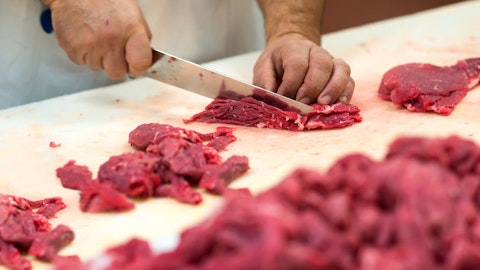Andrew Strelzik: Great that that’s really helpful color. And then, I guess, the second question, I just want to go back to the, to the change to the CapEx guidance for the year. Can you talk about some more specifically to change there does it have any applications for ‘24 CapEx? And I guess just generally as you think about the flexibility of your CapEx budget, is there a way, given projects that are already underway etcetera, to think about, kind of a minimum CapEx budget for next year? I don’t know if there’s a way to frame that. Thank you.
John Tyson: Hey, this is John. I’ll take that question. Let me talk a little about CapEx and just kind of maybe some other related matters on the balance sheet and leverage. So, I think, first off, we have tared back, the CapEx kind of quarter-over-quarter we’ve been managing the spend throughout the year and we feel good about that. Based on our guidance today, you would expect to see about $500 million in Q4, which just worth pointing out that’s still above what has been a historical annual run rate for US of about $1.5 billion. We are targeting to get to that $1.5 billion spend annually. And I think it would be premature to say where the ‘24 number lands but safe to say that we’re trending in that direction. I think, it’s also worth just taking a second to talk about where we are with leverage and because capital obviously capital spend, obviously influences that.
I think, the headline for us is, we’re sitting on a sound balance sheet. And that’s really a product of the capital allocation choices we’ve made through the last few years where we’re really focused on kind of preserving a good financial position, targeting at or around that two-time, leverage number for the long term. So, leverage has increased with where profitability been on LTM basis. But I think overall, we feel good about where we are from being able to managing capital spend standpoint and everything else that we’ve got going on. We’ve made a couple moves, just tried to be tighter on working capital. We pulled that down about $100 million in inventory this quarter just despite what’s going on in the market. So, I think overall, capital spend, working capital efficiency, all in line with long-term leverage number have been, we’re comfortable with where we sit today.
Andrew Strelzik: Thank you very much. I’ll pass it on.
Operator: Our next question comes from Benjamin Theurer from Barclays. Please go ahead with your question.
Benjamin Theurer: Hi, good morning. Thanks for taking my question. Could you talk about your pork margins have to be easily shown you already commented on market conditions, but can you provide more light of company-specific initiatives. Maybe some plant closure assessing maybe it could be an option, anything else if you can provide towards improving operations there?
Donnie King : Hey, Ben, it’s kind of hard to understand you muffled. Do you mind repeating that question? Sorry, because that was – there was a lot in there?
Benjamin Theurer: Sure. On book margin, you already revised this, and market conditions, especially with sales, but can you provide more light on company-specific initiatives, maybe some plant closures? Could have be an option to invest in which you can anything else on pork to improve things? Thanks.
Brady Stewart: Thanks, Benjamin. This is Brady Stewart. Appreciate the question. As Donnie just indicated, we’re evaluating our business in totality. And first and foremost, really, I think we need to unpack those pork results back into the live and the actual fresh pork segments that roll up to the specific BEU. I’m going to speak specifically to our plants and operations from the fresh pork perspective. Very comfortable with our strategy moving forward obviously from a impact perspective, we’re focused on everything from our expenses and expense structure that we have within our assets. The efficiency of our assets we have plans in place to make sure that we focus on better efficiency within those assets. And then obviously, traditional price yield and mix matrices that really provide us the opportunity to maximize the margins and our opportunity to go to market.



